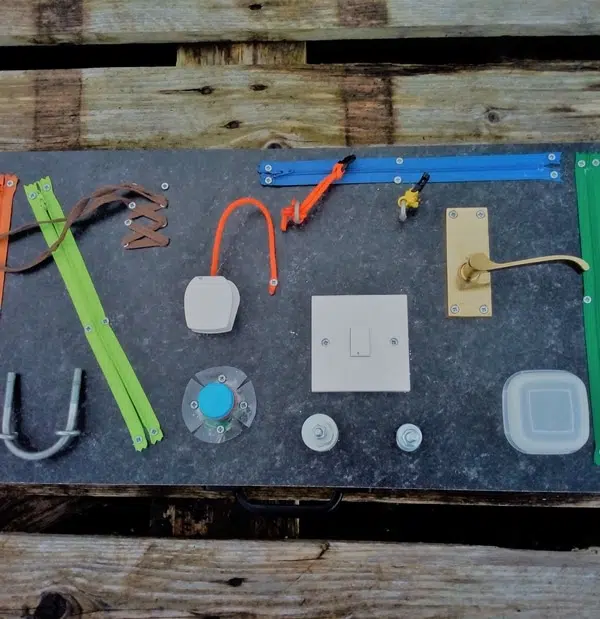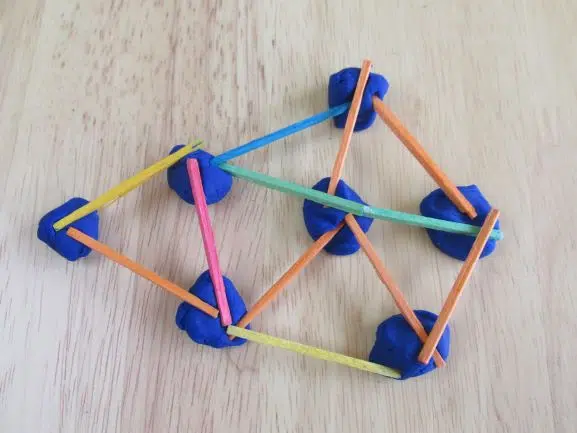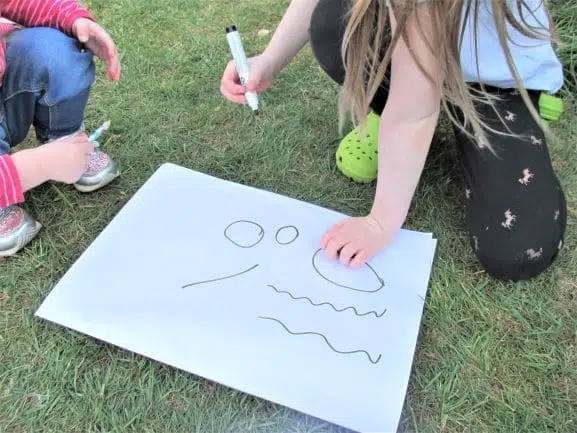It’s easy to take for granted just how much we need fine motor skills day-to-day since many of our movements are so well-trained that we use them without even thinking!
While we tend to think of fine motor activities for kids as pencil work, there’s a much broader set of movements and skills we use and that kids need to learn, especially integrating visual skills (source) and building practical know-how.
As an early elementary teacher and piano instructor, I’ve seen that as our tech-savvy kids grow up with devices that don’t require a range of hand and eye-coordination movements, we need to be more aware of how we can also target fine-motor skills purposefully – not just for academic learning, but for life skills and play as well!
Little fingers, especially in developing hands, follow a progression of development that parents, caregivers, and educators should know what these look like so that children can engage in targeted, developmentally appropriate activities (source).
I’ve worked with many ages and abilities and have come up with fun ways to explain how to move and strengthen their hand-eye coordination and build up fine motor skills gradually.
This helps avoid frustration when children aren’t ready to take on a particular task.
In this article, I’ll list some examples of fine motor skills that are important at different stages with some suggestions that can help strengthen any child’s fine motor skills with easy-to-access materials.
Fine motor skills develop over the course of a child’s life from infancy to age 12, and all children will develop at different rates. Of course, if there’s ever any question, working with a qualified OT is the best course of action.

Infants and Toddlers
We might think of fine motor skills as just small movements we do with the muscles in our hands, but they’re more than that! We develop visual-motor skills at the same time, and these help us control our arms, wrists, and other gross motor skills as well. Gross motor skills are also a big part of how well we control our hands and wrists – it’s all connected!
Babies often use both sides of their body at the same time and gradually start to develop independence and hand preference as they get older.
Infants and toddlers will often use both sides of the body at the same time when they’re young, as their gross motor skills are still developing, and they’re also learning to track objects with their eyes and learn to measure distance.
Here are some early fine motor skill examples we’ll see in infants and toddlers as they grow that make up the foundation of later movements:
- Moving arms and bringing hands to mouth as babies learn to make visual-motor connections.
- Opening and closing hands as they start to develop awareness and grip.
- Grasping and letting go of something as they start to control their hands.
- Bringing toys to mouth integrates grasp and movement.
- Bilateral reaching for someone or something – you’ll notice a smiling baby will reach up with both arms, as it takes time to develop independence on both sides of the body.
- Following movement with eyes – visual tracking is part of hand-eye coordination.
- Pointing – this is the beginning of finger independence. Reading and pointing is a great practice for this.
- Pinching, or using a pincer grasp: think of a baby eating Cheerios.
- Holding a cup and drinking.
- Throwing objects in front of them or down – what baby does not love playing this game for endless hours?
- Waving “bye-bye” with the wrist going forwards and backwards instead of an open-and-closed grasp or moving the whole arm, or from the elbow. This is developing wrist flexion (bending forward) and extension (bending backwards).
- Scribbling with a crayon or marker held in the fist.
- Turning the pages of a book, starting with two or three at a time and then moving to one.
- Stacking objects, starting with two and then moving on to three or four.
- Putting large objects into a container.
- Turning door knobs and big dials – this helps develop control over wrist movement side to side.
- Doing a “thumbs up” is early finger isolation, and so is making the “OK” sign
Preschool
The bones in a child’s hands are not finished forming until up to age 7, so it’s important to remember that fine motor skills at this stage are so much more than just pencil grasp!
Tendons are still loose and so long sessions (more than a few minutes) of forced hand positions are challenging for this age. I have a lot of parents asking about piano lessons for their 3-4-year-olds to develop fine motor skills, but I encourage them to focus on play and wait a few years for just this reason.
These are examples of the wide range of fine motor skills a preschool child may be beginning to explore or master in different areas:
At Daycare or Preschool:
- Cutting with safety scissors – hands may tire quickly, and cuts will be imprecise.
A great way to encourage straighter cuts is to have a child imagine a line on their paper first by using their index finger to trace where they will cut; this helps them integrate the visual skills they need for cutting and making fine movements.
- May be able to draw very basic figures, such as a line, a circle, or a cross – these are prewriting symbols.
Tracing a square or triangle drawn by an adult is also a skill they’ll build now. - Learning the names of different fingers and wiggling them one at a time. Putting stickers on each finger is a fun way to turn this into a game!
- Holding pencils with a fist, either with thumb turned down and the whole arm and shoulder involved, or thumb turned up and more wrist involvement. They may also try to use just their fingertips and use their wrist to write or draw (source).
It’s better if they’re using thick writing utensils like big chalk, egg pencils, and round paint brushes at this stage. - Isolating fingers in activities like finger painting or counting on fingers. Playing finger-counting games like “This Little Piggy” are great for fine motor development – using one finger at a time is part of early fine motor development.
Even counting on fingers while touching each finger or raising them as they count is an important fine motor skill!
At Home:
- Getting dressed takes lots of fine motor skills! This can include putting on and taking off socks and shoes with velcro, and buttoning clothes, although small buttons can still be a challenge.
- Pushing buttons on a remote control, using a tablet, or pushing buttons are all part of fine motor development.
Make sure they’re pushing with the thumb braced against the index finger and not bending too much when pushing hard, or have them make a “rooster head” with the thumb, index, and middle finger for extra stability.
At Play:
- Keeping a balloon up in the air is an example of good visual-motor connections, or chasing and popping bubbles with an index finger helps with finger independence and visual processing.
- Putting tape or stickers on things, and learning to peel them off. Big bubble stickers or masking tape are great for this!
- Using clay or play-dough is one of the all-time favorites for strengthening little hands at all ages. There is no end to how useful working with play-dough can be, from squishing it, to pulling off little pieces, to rolling it into snakes or small balls between the palms or fingers!
It can be really tricky to make balls, so older children will fare better with that skill. - Stacking and linking blocks, like wooden blocks or large MegaBlocks.
- Wrapping different thicknesses of rubber bands around a can or tissue box – this requires pulling and stretching and using different fingers independently.
Preschool-aged children will show a wide range of fine motor skills that need lots and lots of repetition to master, and may need more time with some skills than others. Some may be ready for writing letters earlier or later, but there’s no rush.
The more children at this age wiggle, play, and work with their hands to explore the world around them, the stronger their visual-motor connections will be and the better their fine motor skills will become! It’s also important to note that strong gross-motor skills are important too, as they build the foundation for good posture and muscle control.

Kindergarten to Early Elementary
We might think that fine motor skills start to be limited to writing and pencil work once a child reaches school age, but there’s so much more than just writing skills that children can continue to work on!
Children are still working on building hand-eye coordination and visual processing skills that require more complex, fine movements and focused attention. The following is a list of examples of fine motor skills for school-aged children:
Pencil and Paper:
- Starting to show preference for one hand and developing good grasp, although some children will start earlier or take longer to show true hand dominance.
Children will also start using an acceptable version of a tripod grasp to hold big pencils and markers; some younger children may still need their grip corrected and may revert to a less advanced grip at times but that’s not a sign of a problem unless it’s consistent and uncomfortable.
They will be using a greater variety of writing implements with more ease, but pencils should still be thicker and using pencil grips is still a great idea! - Beginning to write capital letters properly is a classic example of fine motor skills, moving on to lower case letters later. There’s no rush, and writing can look like writing with a pencil, or tracing in the air, or using sand or rice to practice letter formation.
- Doing dot-to-dot drawing is an important example of visual processing and fine motor skills that really challenges children to develop excellent hand and wrist control.
Pencil control activities like tracing between objects is another great example of fine motor control, such as circling, drawing lines to keep things separate, or outlining. - Cutting skills improve, and children start to master rotating the paper to cut zigzags and in circles. A lot of children need explicit help with not using the tip of the scissors to cut and to open them wider and cut closer to the handles in order to strengthen their cutting skills.
- Older children will start using measuring objects such as rulers to draw lines or start to measure as they develop hand independence and use tension to hold the ruler in place as the other hand traces a line.

At Home:
- Opening containers involves a lot of fine motor skills! It requires two hands and a strong grasp, plus keeping the container stable to avoid spills. Start with larger containers like mixing bowls with lids with dry ingredients, then try smaller, tighter-fitting lids.
Twisting open a thermos or water bottle uses the same skills with more wrist control. And peeling the top off of yogurt containers is also a surprisingly hard skill to master! Because the containers are so flimsy, children need to learn to regulate pressure as they stabilize with one hand and peel with the other!
These are (surprising) challenges for a lot of kids but well worth practicing.
- Brushing teeth requires strong wrists and fine flexion and extension movements to get all the teeth. Flossing teeth requires pulling string out, wrapping it, and using fine wrist and finger movements to move the floss between teeth.
For practice, putting together a toothy monster mouth using big marshmallows glued to some cardboard is a great way to learn flossing motions. Stick balled up paper between the teeth to “floss” out. - Helping with supervised meal preparation is a great example of practical fine motor skills in action: kids love tasks like mixing, measuring, and pouring, and these are all great for wrist strength and using hands for precise movements, especially using tongs: kids love to use tongs to help serve at dinner time.
Even setting the table is evidence of the ability to do fine movements like laying and lining up utensils and that they can make visual connections and comparisons.
Cutting soft foods with a butter knife, like butter or cheese, and using a knife to spread are evidence of improving fine motor control. Or what kid doesn’t love making cookies – kids with strong fine motor skills have no trouble with mixing, rolling, and using cookie cutters or scooping cookie dough onto a pan in even spoonfuls.
At Play
- Sorting small varied objects using a pinch grasp, like pebbles, shells, beads, or buttons.
- Threading large beads onto wire or pipe cleaners; threading onto string can be a little challenging but with practice, some children are ready to move on to smaller beads with wire, or can stick with large beads and thicker string.
- Wrapping yarn onto something; making pompoms is a great way to strengthen wrist and finger movements.
- Cutting string, thin cardboard, snack packages, or other materials.
- Glueing paper, sequins, foam shapes, or other small objects that are sticky and require finger independence.
- Playing video games with a controller requires finger and hand independence and some games require balance as well.
- Tying a basic knot with large strips of fabric, and later, shoelaces. Using fabric scraps is a great way to make a decorative garland that makes knot-tying practice fun.
- Playing an instrument, such as piano, ukulele, recorder, or drums. Piano is excellent as early method books start out with one-handed songs then begin to build mirrored two-handed skills and move on to hand independence, where two hands are doing something completely different at the same time!
Children who are interested in guitar may want to start out with ukulele, as it has fewer strings that are easier to press.
One of the most practical sets of fine motor skills children can have as they start school is opening their lunch boxes and snacks – so many young children struggle to open different packages and twist-off tops, so practice this at home to build confidence and independence!
Overall, there are so many surprising examples of ways children can build fine motor skills in day-to-day activities that the possibilities are endless.
The best way for these skills to grow is for children to experience them through play and doing safe tasks independently and repeatedly.
Having strong fine motor skills is the foundation for exploration and problem-solving, which helps children build confidence. While these skills are vital for academic work, you can also see how they go far beyond paper and pencil!
I hope this gets you thinking about other ways you can encourage the children in your life to build their fine motor skills as they learn and grow!
